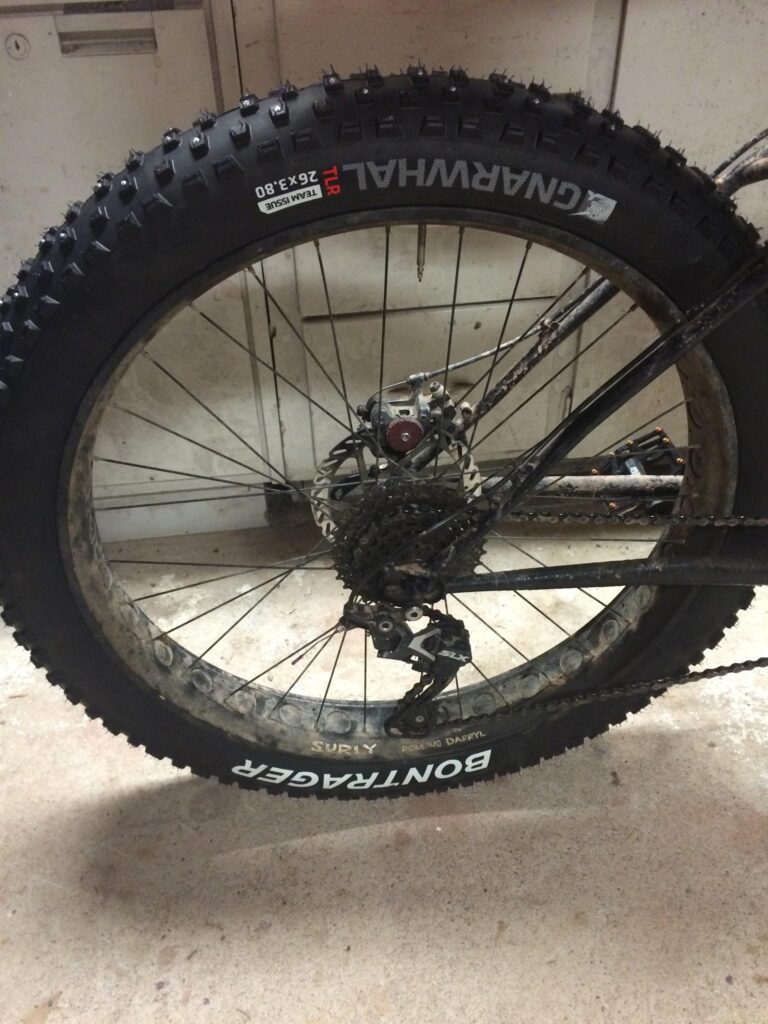
After holding out on dropping the mad dollars for some studded fat bike tires for a few years, I finally caved. Here’s what I found out.
When I first got my Surly Pugsley, I was an instant believer in the platform. I picked it up in February took it home and bombed around in the snow in my back yard. All the hype about the fat tires in snow was the real deal. And fun? Forget about it.
As I continued to ride through the winter, both for fun and commuting, one thing became clear: though the platform was great for the snow, ice still held it’s own challenges and in some extreme cases of ice, even the fatter tires were no improvement over a conventional sized tire. You simply couldn’t ride in some instances without studs of some kind. I started to research a bit.
To the best of my recollection, that same year, 45NRTH were the first to come out with a production studded fat bike tire, the Dillinger. I wanted some instantly. Then I saw the price. Around $250 PER TIRE. I was floored, but I also thought that this was a new market, and over time, prices would come down. I resigned myself to wait. Winter ended, summer passed. Fall began. I started to think about the fatbike again and the struggles I’d had on ice. I decided to bite the bullet and order some Dillingers. Problem was, this was when the winter fat bike boom was really starting to take off. Couldn’t get ’em in my neck of the woods. I had an order in but the distributor had already sold out for the season and wasn’t expecting more stock. I gave up on getting any that winter early on.
Late in the winter after spending too much time in internet rabbit holes, I decided to have a go with some DIY chains. I don’t want to detail the whole process I used here – maybe that’s for another post. Suffice to say, they only worked so-so, I had some problems with frame rub/contact, and one eventually broke mid-ride so I said screw it and took ’em off.
For quite awhile, 45NRTH were the only ones out there making a studded fat bike tire so they had the market cornered. The last year or so has seen a ridiculous boom in fat bike popularity, last year pretty much every major manufacturer added at least one model to the product line up. Major players Trek/Bontrager jumped into the game with both feet – adding not only bikes, but several fat bike tires to the catalog including the studded Gnarwhal. My LBS where I work part time is a Trek dealer, so I was hoping this would make it easier for me to get a set, and it did.
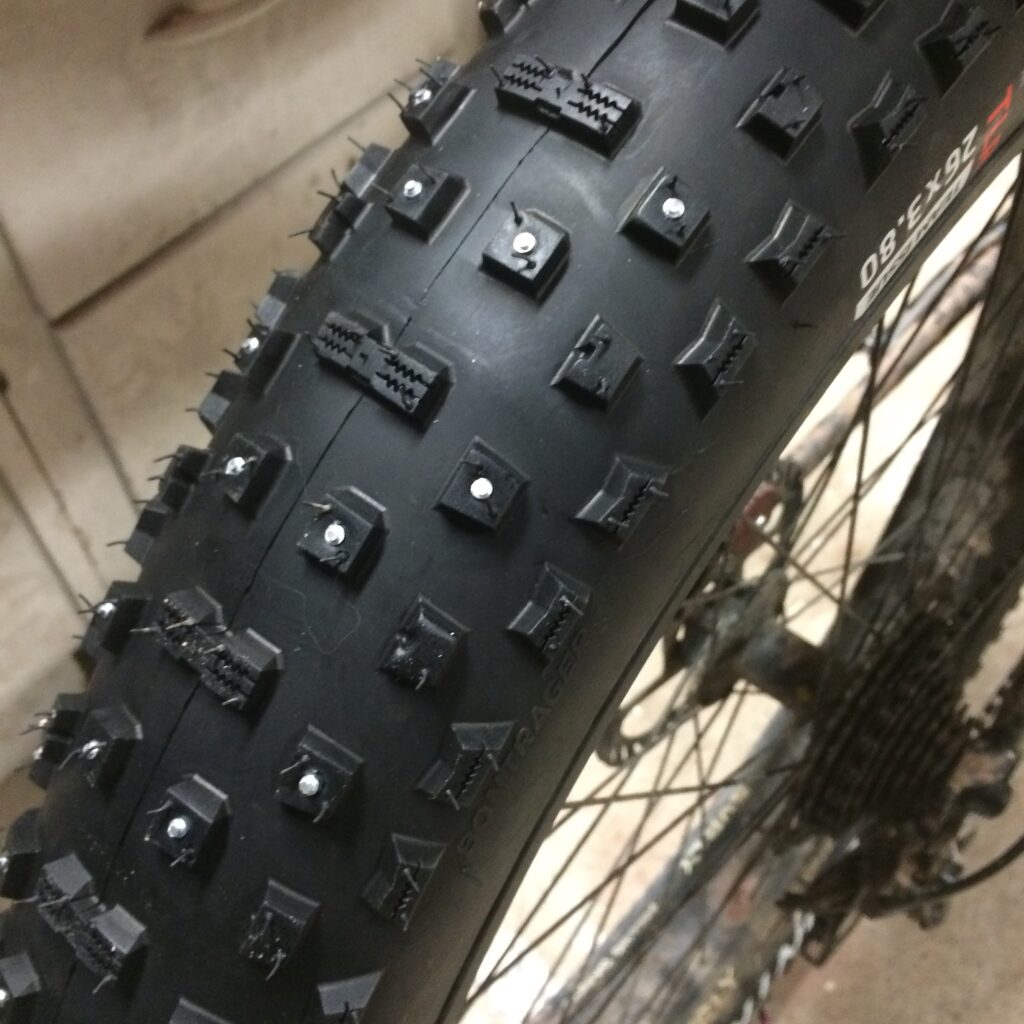
Specs
So, the lowdown. The Gnarwhal is a 26″x3.8 tire available with or without studs. The studded version includes 160 installed Tungsten carbide studs. The Gnarwhal is (TLR) tubeless-ready (I run ’em with tubes) and according to Trek’s site the “Inner Strength casing is lightweight sidewall protection that’s supple and strong.” There’s a bit of discrepancy on the web about whether these tires are 60 or 120 tpi. Apparently Trek’s dealer site says 120, while the consumer site doesn’t say anything. Some people on the web have posted photos of packaging labeled 60 tpi. I didn’t check mine before I threw it away, so I’m out of luck. I’m not really the type of rider who could tell the difference between a 60 and 120 tpi tire, so if that matters to you, you’ll have to dig around on the web some more or check directly with Trek.
I mounted these up on my 82mm Rolling Darryl rims and though I didn’t measure them, they look to be a solid 3.8″ – in line with my Nates. In fact they look a little bigger, but it could just be the tread/knob pattern and/or my Nates are pretty worn. The knobs are uniformly distributed and though the tires are directional, they are not front/rear specific. I’ve never been one to care much about bike/component weights – at least not on a steel fat bike – but if you must know the Gnarwhals tip the scales at 1360grams.
The Ride
Ok, so after getting ’em home and finding the time to mount them up – as it typically goes for me – I had zero time to actually get out and ride ’em for at least a week or two. Sigh.
But the time finally came. The freeze/thaw cycle of a few days here set up the snowmobile trails around my area as a perfect testing ground for theses suckers. Days of thawing/melting and nights of well below freezing temps meant the trails were pretty much ready for ice skating – or studded fat bike tires.
Plowing through the packed snow on the way to the trails, the Gnarwhals performed as expected, and just as well as my Nates. No surprise there. They hooked up well in the snow and inspired confidence. Once I hit the ice, things ratcheted up a notch.
First thing you notice is the reassuring crunch of the studs on the ice. I had my tires a bit over inflated, but even still the Gnarwhals grabbed on and didn’t let go. I felt like things were a little squirrelly in some off-camber ruts. I stopped and let some air out of the tires to get some more float and increase the footprint, and hopefully increase engagement of the studs. Note: I usually go by the ‘feel’ method for inflation, but since I planned on writing this up and figured people would want to know, I checked when I got home. For the majority of the ride it would seem I was running around 5psi front/7psi rear.
On straight up ice, the tires performed fantastic. The more time I spent on them the more used to them I became. I’ve never been in a situation like those super-extreme explorer guys who’s gear means the ‘difference between life and death’ – I’ve never had to trust my life to an ice axe. However, I was placing a lot of faith in these tires, hauling along at pretty good speeds on straight ice. Taking a digger in these conditions could – at the very least – hurt real good, or worse, break something.
The Gnarwhals didn’t fail me. Only once or twice did I get a ‘whoa’ moment of slippage. Usually in instances of off-camber ice ruts/bumps or water on top of ice, and even then they caught after slipping and I corrected. It did make me wonder though, why there wasn’t more studs in the tire. As one person on the web in a review I read pointed out, “I never found myself saying, gee, I wish there wasn’t so many studs in the tire.” I’m left to wonder why Bontrager didn’t opt to stud more of the knobs – particularly on the outside, for turning and such. I guess it’s conceivable that at some point, even with studs, if you’re that much on the outside edges of the tire, nothing is going to hold on given the forces at work. One might assume it was also a cost/weight issue, but I’d have taken more of each for this kind of tire to potentially get increased performance and security.
By point of comparison, 45NRTH’s Dillingers offer 250 and 258 studs per tire for the Dillinger 4 and 5 respectively, and at only a moderate price increase depending on where you shop.
The Down Lo
So straight up – am I happy with them? Yes. They are definitely spendy, but if you’re going to be doing this specific type of riding, I think it somewhat justifies the cost of specific equipment. The security and performance they offer is certainly worth the cost. After going without and trying the chains, I’d definitely say there’s no substitute for a proper studded tire – there’s just no comparison. By removing them each season and trying to minimize riding them on pavement, one would hope they offer good value (hold up over time/several seasons), but only time will tell.

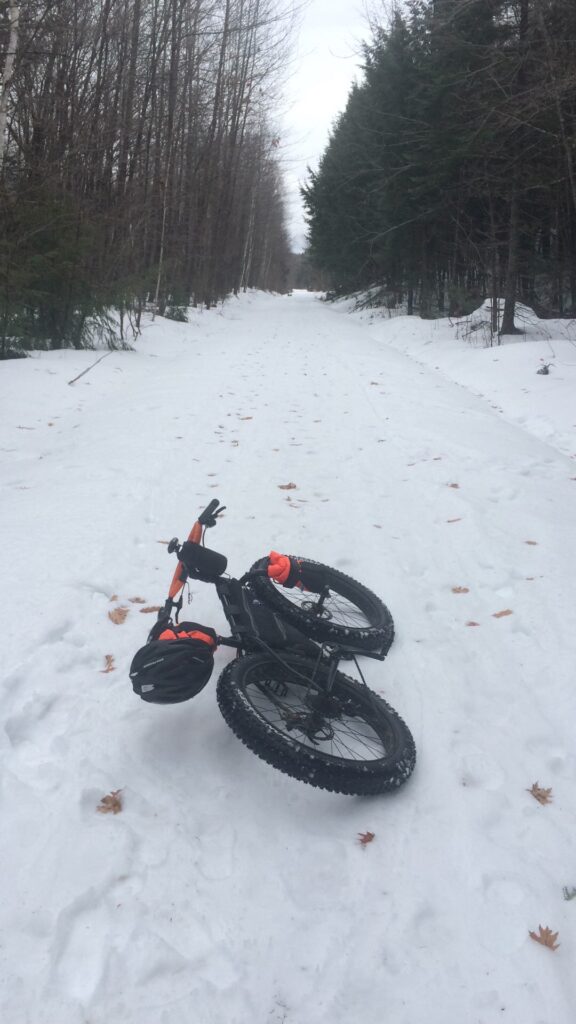
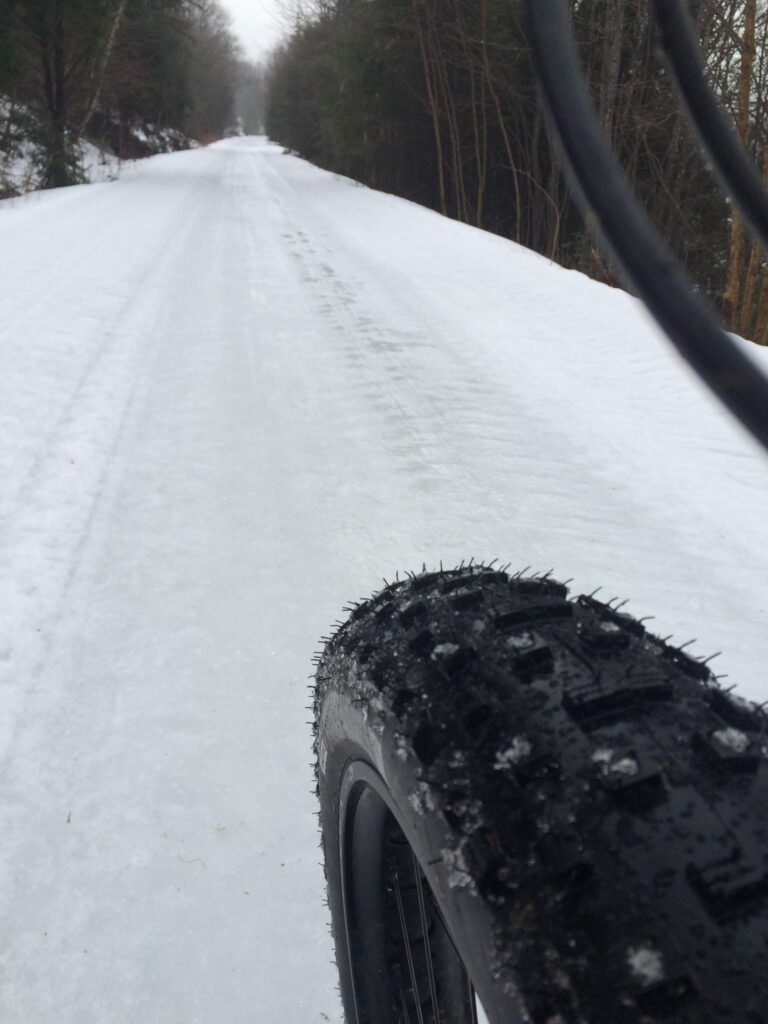
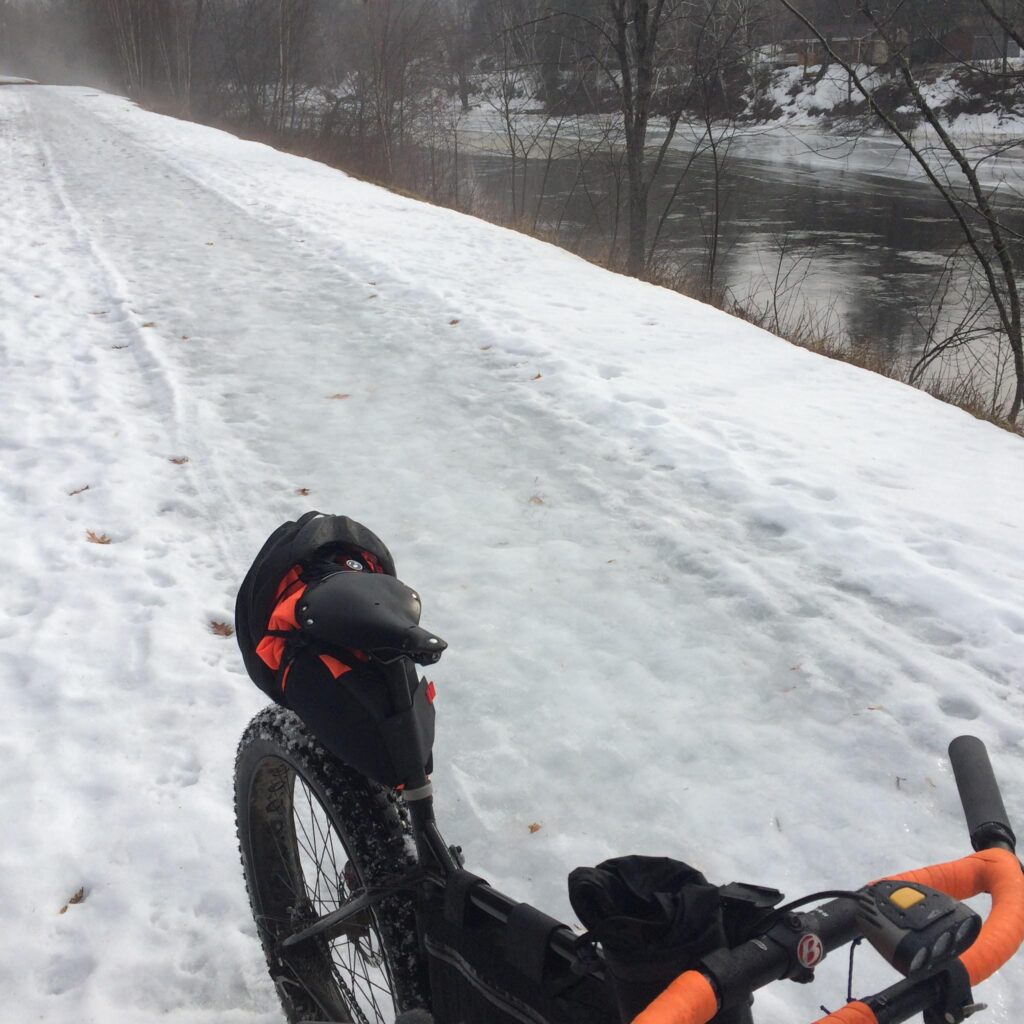
Thanks for the review Kent! 🙂
Thank you for the review – always helpful to hear real world experiences from someone in the same boat. I did the DIY version with screws (164 per tire) – end result was a bit heavy, and don’t think they will last as long as your Tungsten carbide studs – but they were a fraction of the price in $ – I paid in time and weight. Next we will see if I purchase some proper ones, or re-visit the DIY model. I found the same – regardless of tire width – ice is ice, and it is slippery – studs help. Keep smiling, and keep riding! See you on the trails.
Good points Andre, and good on ya for going the DIY route. I thought about trying that, but after my chain experience and the work involved, I wanted to try the real deal. Thanks for reading and commenting!
Homemade ice solutions are ok for occasional ice, but for sheet ice like you have pictured, factory studs are the way to go! The TLR capability and the lower stud count seem to make this a higher performance option than the Dillingers, so maybe style of riding would determine which is the best choice. Thanks for the review.